 SOUTHAMPTON COLONIAL SOCIETY purchased the Halsey House in 1958 and restored it in 1960.
SOUTHAMPTON COLONIAL SOCIETY purchased the Halsey House in 1958 and restored it in 1960.
Halsey House, South Main Street, Southampton
Historic Structure Report*
Prepared for the Southampton Historical Museum (Southampton Colonial Society) by Robert Hefner,
with Research by Rosanne Barons, February, 2014.
—————————
The purpose of this historic structure report is to organize the data and to use it, along with research of historic documents, to better understand the Halsey House. The result is a narrative of the Halsey House that attempts to reconcile the physical evidence of the timber frame with the written evidence of historic documents. Analysis of all of the available data suggests that Thomas Halsey Jr. built the original house to face south between 1678 and 1688 and that his son, Captain Isaac Halsey, turned the house to face Main Street, and extensively remodeled it between 1720 and 1740. Although this is a reasoned narrative, it is conjectural and questions remain.
—————————
The 1677 will of Thomas Halsey Sr. describes his house as having a “porch chamber,” which would have been the upper room of a two-story enclosed porch projecting from the chimney bay and containing the front entrance on the first floor. Physical evidence shows that the Halsey House did not have a porch or porch chamber and, therefore, is not the house of Thomas Halsey Sr.
Thomas Halsey Jr. inherited his father’s Main Street home lot and house in 1678. In Thomas Halsey Jr.’s will of 1688 he gave “unto my wife Mary Dureing the time of her widowhood the one halfe of my new house that I built at the towne namly The west Leantoo and halfe the north Leantoo and halfe the sellar.” A house built by an Englishman on eastern Long Island in the seventeenth century with a west lean-to and a north lean-to would have faced south and had a rear lean-to extending to the north and a lean-to built against the west gable end.
Physical evidence in the frame of the Halsey House indicates that, if the original house faced south, then it did have a rear lean-to on the north wall and lean-to on the west gable wall. Presuming a south orientation, we can conclude that the Halsey House is the “new house” described by Thomas Halsey Jr. in his will. This “new house” was built between 1678 and 1688. There is no known event during this period that would suggest a particular year. Rather than repeat the period of construction as being “between 1678 and 1688,” this report refers to the middle of this period for the short-hand attributed date of ca. 1683.
There is sufficient documentation to confirm that the Halsey House stands on what was the home lot of Thomas Halsey Sr. from the 1650s to 1678. The home lot was then owned by Thomas Halsey Jr. from 1678 to 1688 and by Captain Isaac Halsey from 1689 to at least 1746.
This report proceeds from the reasonable conclusions that this is Thomas Halsey Jr.’s house and that he built it facing south. Captain Isaac Halsey inherited his father’s Main Street home lot and house in 1689. Evidence in the timber frame suggests that between about 1720 and about 1740, Isaac Halsey undertook an extensive remodeling. First he took off the roof frame, demolished the north lean-to, demolished the west lean-to and removed most of the framing of the chimney bay. Isaac Halsey retained only the two-story, nearly cubic frame (18′ wide x 18′ deep x 16′ high) of the hall and hall chamber. This report assumes that Captain Isaac Halsey revolved this small box frame to face east toward Main Street. He then rebuilt the chimney-bay, added a two-story south addition, built a larger rear lean-to and covered the whole with a new roof. This report attributes the short-hand date of c. 1730 to this conjectural remodeling by Captain Isaac Halsey.
————————————————————————————-

THOMAS HALSEY Jr.’s ca. 1683 HOUSE
On the first floor of Thomas Halsey Jr.’s south-facing house was the large hall to the east, an entry and stairway in the chimney bay, a parlor in the west lean-to and service rooms in the north lean-to. The hall remains extant today with the original posts, girts, summer beam and floor joists visible within the room. The hall was the main living and cooking area with a large hearth and a bake oven in the fireplace. The hall had windows in the south and east walls and doorways to the entry and to the rear lean-to….
The hall chamber was the major room on the second floor and is the only extant second-floor room of the original house. Original framing members, particularly the summer beam and floor joists, remain exposed in the room. The hall chamber was the only second-floor room to have a fireplace. Windows were in the south and east walls. The second-floor rooms of the west and north lean-tos were not heated, were not well lit and were probably used for storage….
————————————————————————————-

______________________________________________

______________________________________________
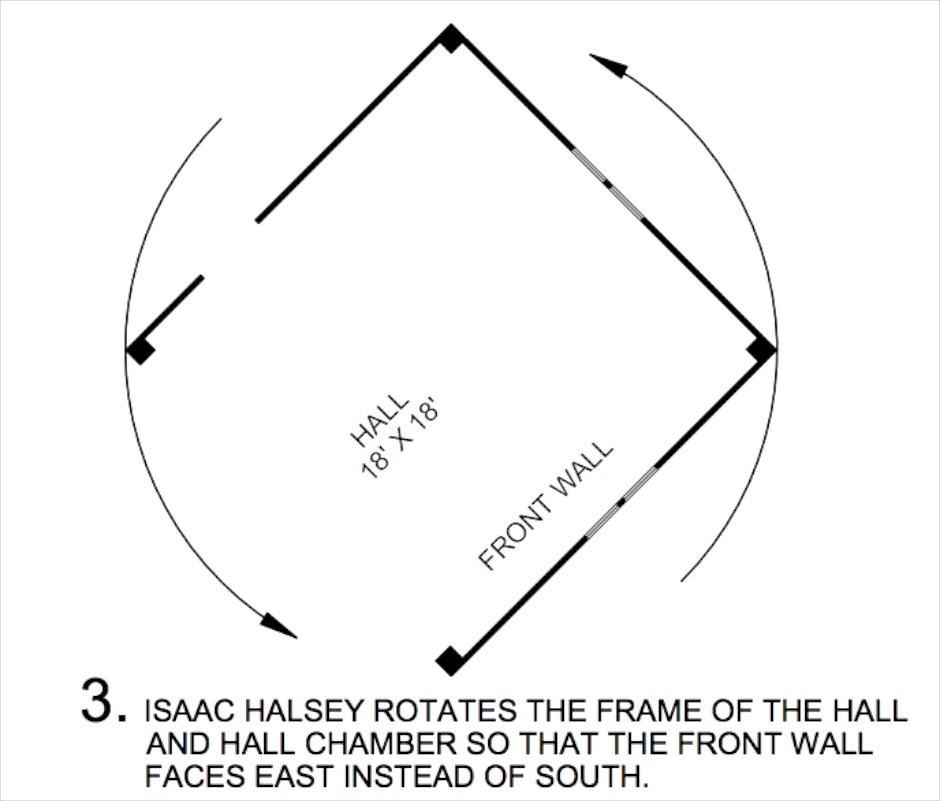
______________________________________________
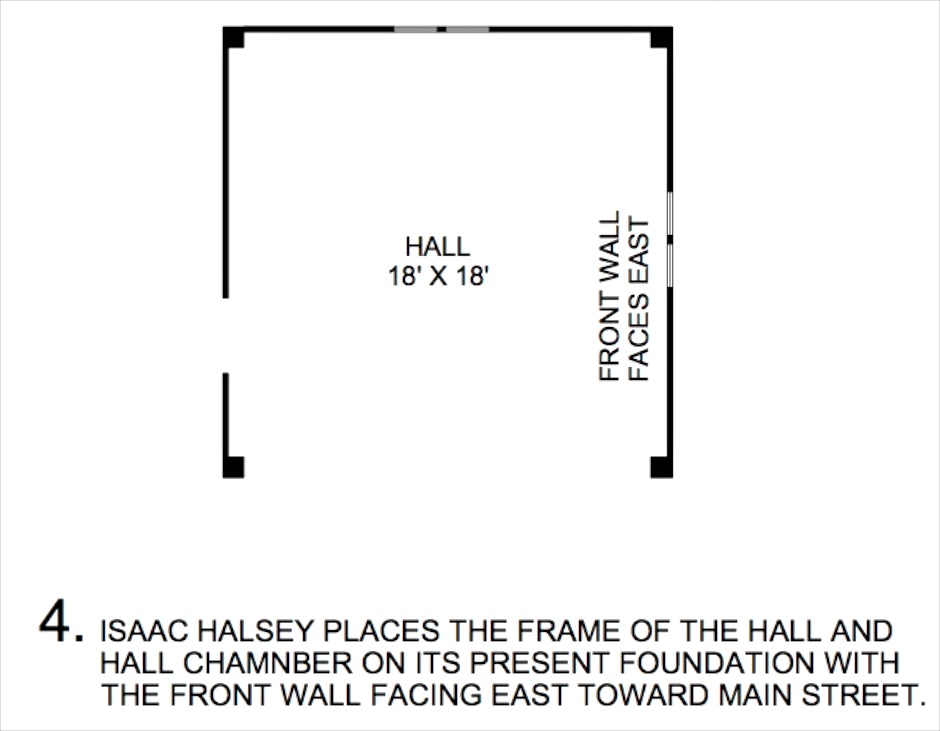
______________________________________________
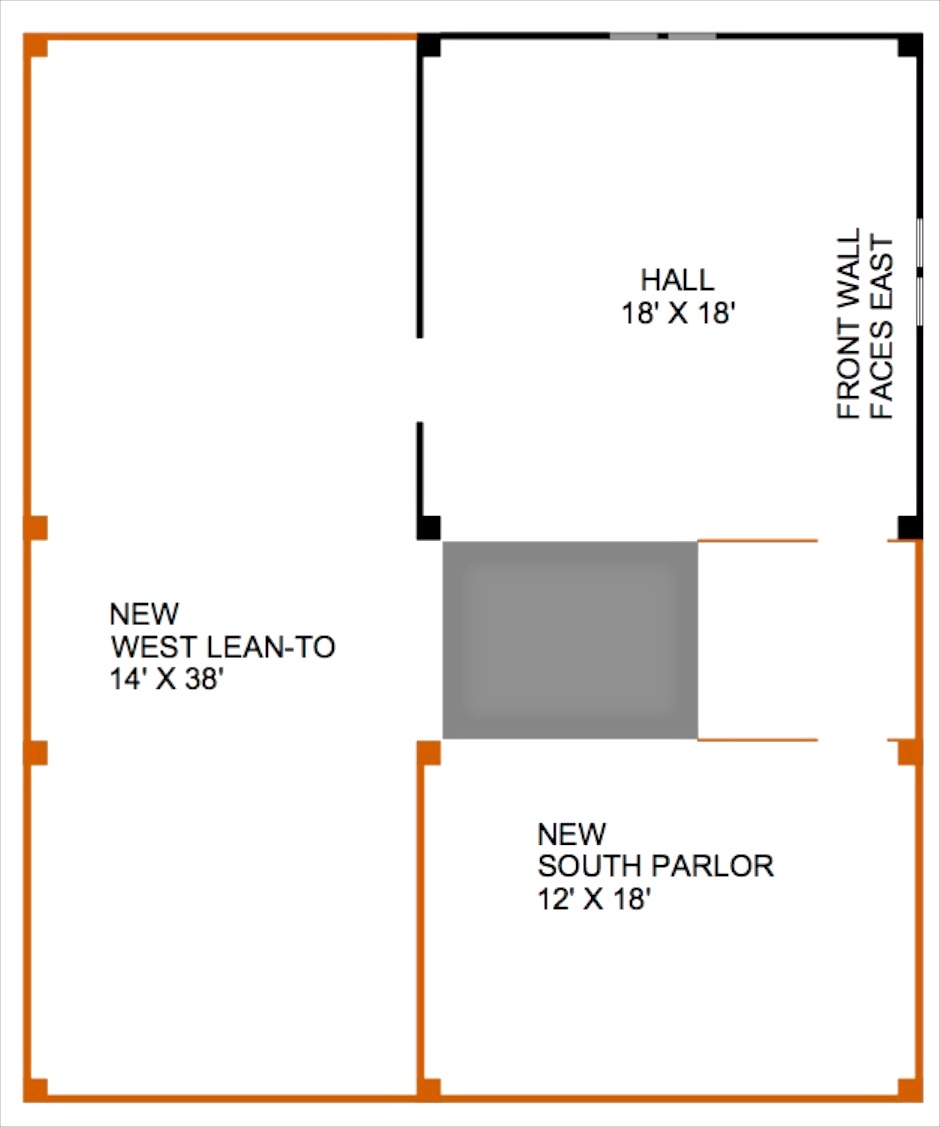
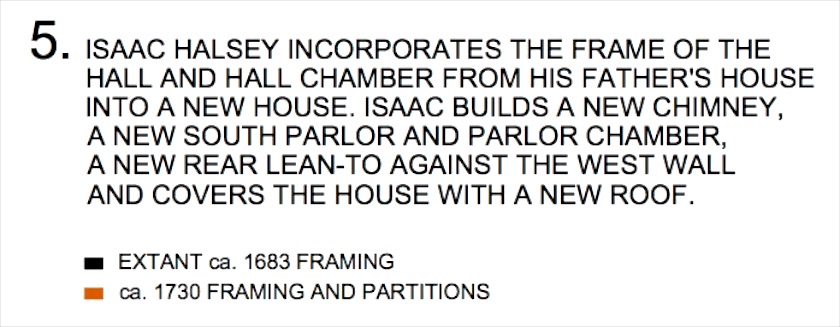
A COMPLETE REMODELING BY CAPTAIN ISAAC HALSEY, ca. 1730
On the first floor, only the hall remained intact from Thomas Halsey Jr.’s ca. 1683 house. The kitchen may have remained in this room, but it is likely that the new lean-to was furnished with a cooking hearth and bake oven. The new south parlor was a smaller room than the hall, but this would have been the new “best room” with a more fashionable interior and windows in the south wall. The new lean-to across the rear was a much larger room than was the rear lean-to of the ca. 1683 house. Following traditional practice, this room would have had a buttery and pantry at the north end, a large center room, probably with a cooking hearth, and a small bedroom at the south end.
The frame of Thomas Halsey Jr.’s ca. 1683 house displayed the timber framer’s craft as a continuation of English practice. Large timbers were hewn to a smooth surface and the exposed interior surfaces were decorated with careful chamfers, moldings and stops. Smaller members, such as wall studs and floor joists, were converted from large logs which were hewn square, halved and then each half sawn into two or three studs or joists. The floor frame of a large summer beam carrying small joists was at the heart of this building tradition.
The framing of Captain Isaac Halsey’s ca. 1730 additions demonstrates an evolution in the local building tradition that began to take place around 1720. Rather than the laborious sawing required for the high-quality wall studs of the original house, for the ca. 1730 construction, small saplings were roughly hewn square. This was much faster work and for some studs, only the exterior and interior faces were hewn, with the bark left on the sides. The floor frame of the parlor chamber shows a similar evolution. Instead of a summer beam carrying small joists, boxed-heart joists span the room. In a continuation of early practice, these joists are exposed in the parlor ceiling, but the surface finish is not as refined as is the finish of the summer beams and joists of the ca. 1683 house. The corner posts are also exposed in the room and these also have rougher surfaces and slighter chamfers in comparison to the seventeenth-century posts of the hall and hall chamber.
————————————————————————————-
1800 RENOVATION
Some evidence remains of a late-eighteenth-century renovation. The work included replacing the ca. 1683 casement windows and the ca. 1730 casement windows with new plank-frame windows having up-and-down sash, covering the exposed ceiling joists with new plaster ceilings and installing new paneling and chair rails….Because so little fabric from this period remains, it is not possible to have a full understanding of the scope of the work or to have a good sense of when it occurred. This work could have been undertaken by James Raynor, who owned the Halsey House from about 1800 to 1812, or by an earlier owner. This renovation is given the short-hand attributed date of ca. 1800 in this report….
————————————————————————————-
1900 RENOVATION by ARTHUR J. PEABODY
An extensive renovation undertaken by Arthur J. Peabody about 1900 resulted in the removal of many earlier exterior and interior features. The house was raised 18” to provide more headroom in the first-floor rooms. First floor rooms were given new interiors. Some old vertical pine paneling, now 18” too short, was recycled as exterior sheathing….
New windows were installed throughout the house at this time. A new front door was installed. It is likely that second-floor rooms were also given new interiors during this renovation. The ca. 1900 work also included a two-story north addition and a large west addition.
————————————————————————————-
1960 RENOVATION BY THE SOUTHAMPTON COLONIAL SOCIETY
The direction of the 1960 restoration of the Halsey House was taken from some key discoveries made by architect Robert L. Raley. When the north wing was taken down, Mr. Raley discovered that the hall and hall chamber had seventeenth-century framing while the lean-to was an eighteenth-century addition. Following this discovery, Robert Raley found that the parlor and parlor chamber were also eighteenth century. Riley concluded that the original house consisted of one room on each floor with a chimney and a stairway in the chimney bay. His discovery of part of a “leaded glass casement frame” in the north wall of the hall chamber completed the concept for the exterior. Replica leaded-glass casement windows were installed in the hall, hall chamber and chimney bay. A replica of a seventeenth-century door became the new entrance in the chimney bay. Replicas of eighteenth-century windows with a up and down sash were placed to light the parlor, parlor chamber and lean-to. Mr. Raley designed seventeeth-centruy interiors of the hall, hall chamber and chimney bay. The summer beams and joists of the ceilings and major frame members of the walls were exposed within these rooms. Elsewhere he specified eighteenth-century interiors, incorporating some recycled woodwork in the parlor.
————————————————————————————-

1999 RENOVATION BY THE SOUTHAMPTON COLONIAL SOCIETY
The Southampton Colonial Society undertook a project to install new three-foot shingles on the Halsey House in 1999. Nathan Tuttle was the contractor and he was assisted by Gary Tuttle. This writer supervised the work. Upon removing singles, it became apparent that areas of the timber frame were severely deteriorated. The Society expanded the scope of work to include making necessary repairs to the timber frame. All of the existing sheathing was removed to inspect and repair the frame. By the fall of 2000, the frame was repaired and the new shingles installed.
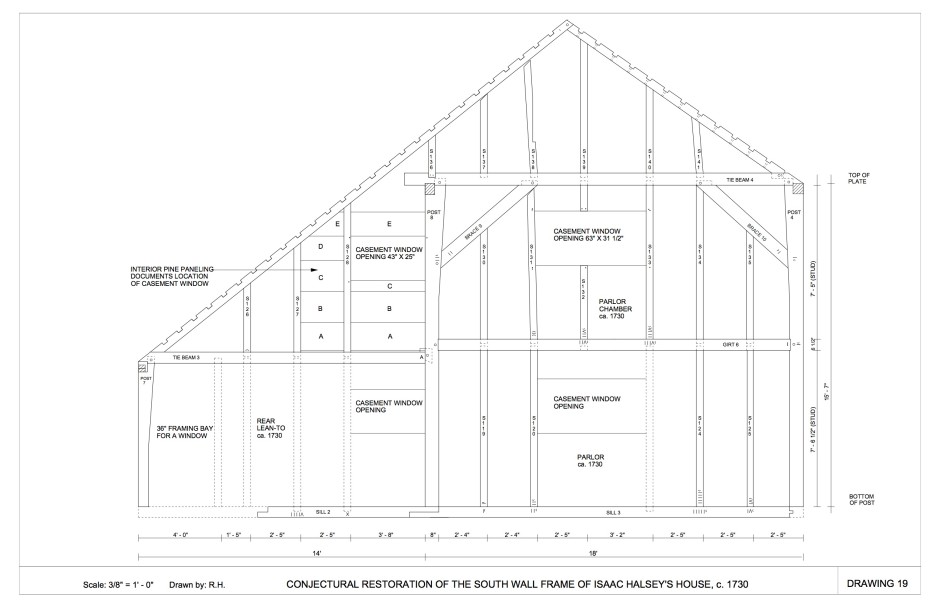
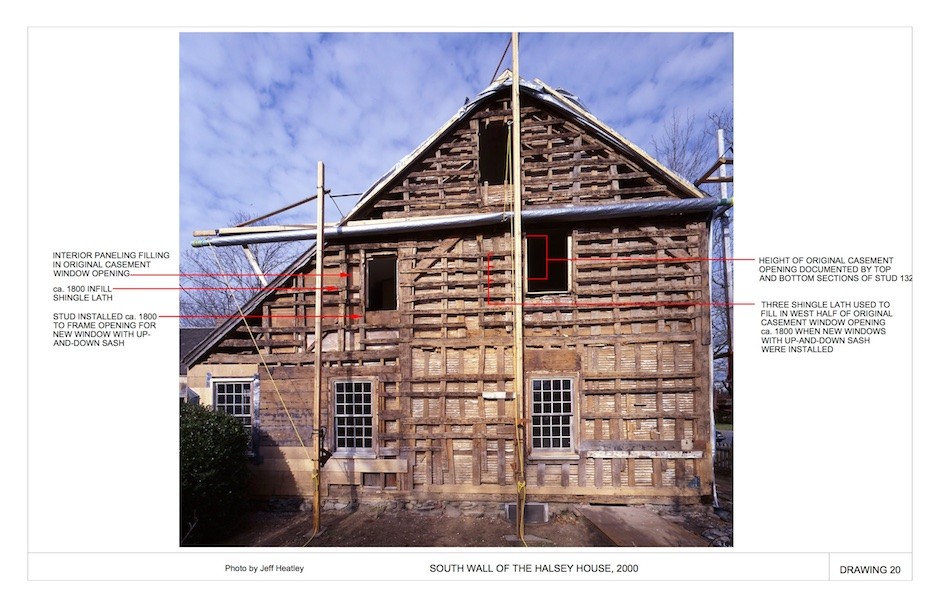



———————————-
*This is an abridged version of the 93-page Historic Structure Report — for a complete document please contact the Southampton Historical Museum.
Halsey House, South Main Street, Southampton, N.Y. — Historic Structure Report — Prepared for Southampton Historical Museum (Southampton Colonial Society) by Robert Hefner, with research by Rosanne Barons, February, 2014.
Courtesy of the Southampton Historical Museum and Robert Hefner.
———————————-
Visit: AAQ / Landmark: Halsey House, 1680, Southampton
______________________________________________
